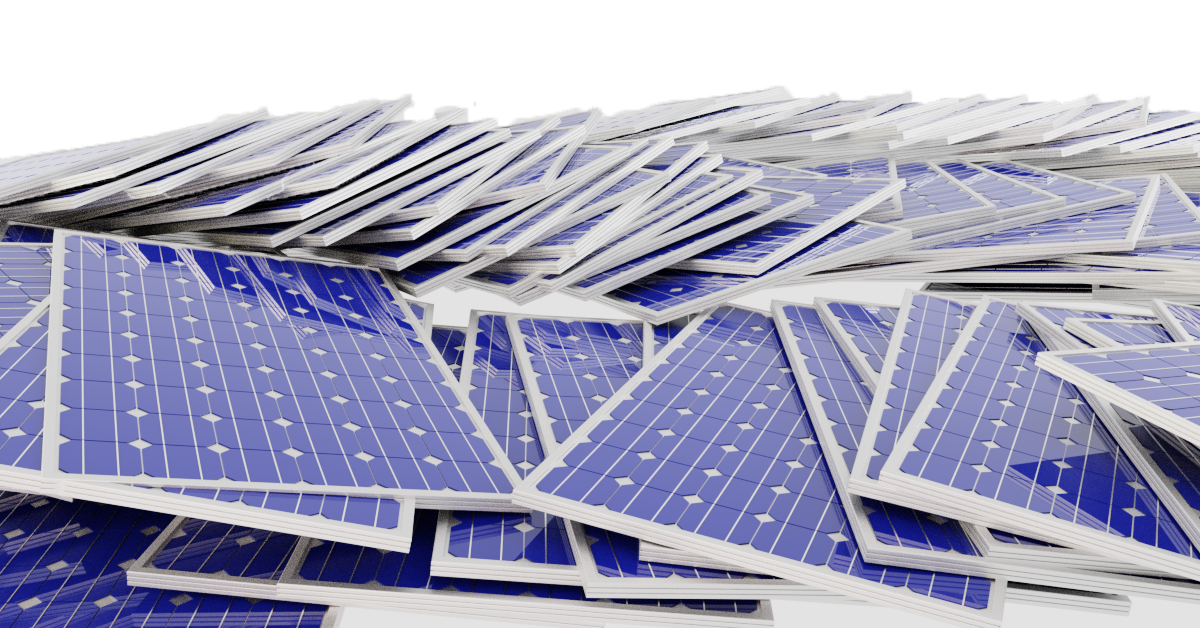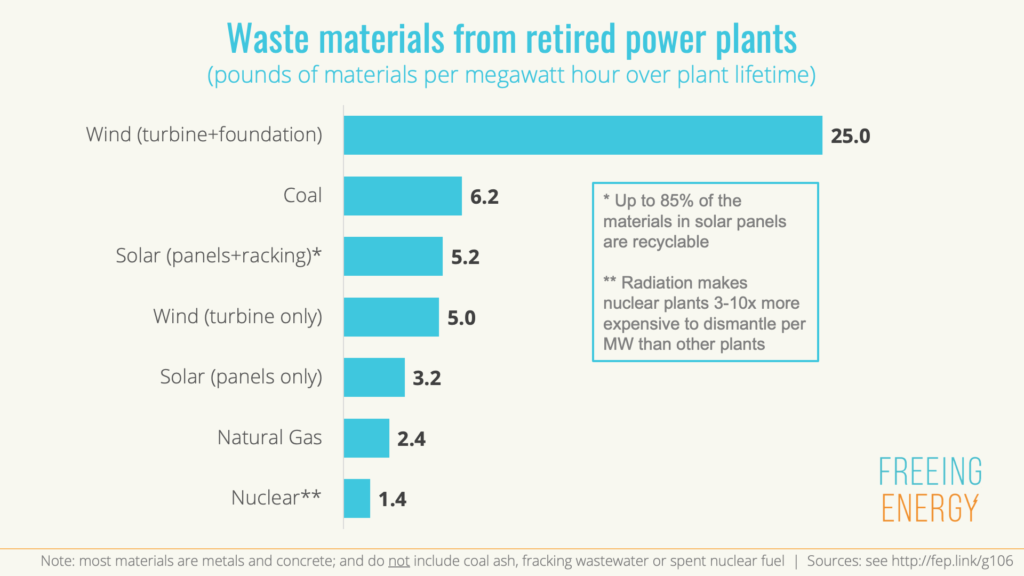In 2018, the US installed 10.6 gigawatts (GW) of solar1, which weighed about 689,000 tons2. In 30-40 years, when it’s time to retire these installations, we’ll have to do something with all this solar panel waste. How big of a problem is this going to be?
Some concerns about solar panel waste are greatly exaggerated
First, let’s look at the concerns that critics often exaggerate and are easy to address.
- Solar panels contain toxic materials. This concern applies to a tiny segment of solar that uses a material called cadmium telluride (CdTe). Only about 2% of panels use CdTe and that segment is shrinking3. Solar panels do contain trace amounts of lead, but the same is true of any other electronic product that uses soldering.
- Solar installations use massive amounts of concrete. This is simply not the case. Outside a few specialized use cases, like solar built on old landfills, there is little to no concrete used in installations. References to this appear to be based on a few studies done 15-25 years ago.
Solar installations are the most recyclable way to generate electricity
One of the more legitimate and unique challenges to solar is that sunlight is diffuse, requiring a large number of panels to capture its energy. Fortunately, solar panels are straightforward to recycle. According to a report by the International Renewable Energy Agency,
“The major components of [silicon] panels, including glass, aluminium, and copper, can be recovered at cumulative yields greater than 85% by panel mass through a purely mechanical separation.”4.
All three of these components have well-established recycling industries so the majority of each of these panels will never end up in landfills.
Another large component of solar installations is the steel racking that anchors the panels to rooftops and the ground. In most cases, the installation will continue producing electricity so the steel racking will remain in place as the retiring panels are replaced with new ones. However, if a site is ultimately decommissioned, the market for recycled steel is quite mature so very little of it will require disposal.
GET MONTHLY NEWS & ANALYSIS
Unsubscribe anytime. We will never sell your email or spam you.
Disposing of solar panel waste is a tiny part of a much larger problem
For better or worse, even as the growth in solar installations picks up speed beyond the 689,000 tons in 2018, disposing of retired solar arrays will remain a small part of a much larger waste problem. For example, e-waste like televisions, mobile phones, and computers, creates 6.3 million tons of waste a year in the US and is growing quickly5. And, e-waste is just a tiny part of the 250 million tons of waste generated in the US every year6.
To put solar’s waste challenge in perspective, let’s look at the construction waste from coal, natural gas, and nuclear plants on an apples-to-apples basis. When you divide the total construction materials by the number of megawatt hours produced over the plant’s lifetime, you see that solar panel waste is very similar to coal, natural gas, and nuclear.
The biggest difference with solar and wind over fossil and nuclear fuels is that they produce no waste while they generate electricity. Including this important metric shows that the steel and other materials from retired plants is a tiny portion of the waste created while operating traditional thermal plants. These waste products can be substantial and they accumulate with every megawatt hour of electricity generated.
- Fracking waste water. Burning natural gas doesn’t produce any solid waste but getting it out of the ground does. It takes 7,600 cubic feet of natural gas to generate a megawatt hour of electricity7. Using high pressure to extract that gas also brings up about 26 gallons of waste water, which weighs 220 pounds8.
- Coal ash. Burning coal leaves behind coal ash, a powdery material that contains a pollution stew of chemicals like arsenic, uranium, chromium, and mercury. Burning enough coal to generate a megawatt hour of electricity creates 186 pounds of coal ash9. More than 100 million tons are created a year, making it the second-largest industrial waste stream in the US.
- Uranium / nuclear. Nuclear power plants consume enriched uranium to generate electricity. This fuel is incredibly concentrated so it leaves behind a relatively small amount of nuclear waste by weight. However, a great deal of waste comes from making the fuel. It takes about 50 pounds of uranium ore to create the enriched uranium necessary to generate a megawatt hour of electricity10.
Building power plants uses a lot of material that needs to be disposed of when the plants are decommissioned. For plants like solar and wind that don’t use fuel, their waste can only be measured in terms of the total megawatt hours generated over the plant’s lifetime.
The materials used to construct power plants
(pounds per thousand kilowatt hours - MWh)| Generation Type | Metal and Concrete (pounds / MWh) |
|---|---|
| Nuclear | 1.4 |
| Natural gas | 2.4 |
| Solar (panels only) | 3.2 |
| Wind (tower + turbine) | 5.0 |
| Solar (panels + racking) | 5.2 |
| Coal | 6.2 |
| Geothermal | 15.6 |
| Wind (+ concrete foundation) | 25.0 |
| Hydropower | 54.2 |
- Coal power plant. Constructing a standard 500 megawatt coal plant requires about 250,000 metric tonnes of materials like steel and concrete. When measured against the lifetime of electricity created, it results in 6.2 pounds of waste material per megawatt hour generated((“How many pounds of steel and cement are used in a coal plant?“, Freeing Energy)).
- Wind turbine. These 200-300 foot high structures are built mostly with steel and weigh an average of 300 metric tons which is 5 pounds of materials per lifetime megawatt hour generated. If you also include the concrete pads securing the towers to the ground, turbines require about 25 pounds of material per lifetime megawatt hour((“How much concrete and steel is needed to build new wind turbines, measured by MWh?“, Freeing Energy)).
- Nuclear power plant. A standard nuclear plant, like an AP-1000 contains 330,000 tons of metal and concrete. When it’s decommissioned, it will require disposal of 1.4 pounds of waste material for every megawatt hour generated over its lifetime11. Because most of these materials are radioactive, disposal costs per pound are far higher than any other kind of energy.
- Solar arrays. A single solar panel weighs between 35-60 pounds and generates between 280 and 330 watts. In 2018, this worked out to about 65 metric tons per megawatt of panels12. Improvements in panel efficiency will continue driving this lower. Retiring these panels results in about 3.2 pounds of waste per lifetime MWh generated13. Adding in steel racking increases this by about 50% for rooftop solar14 and 100% for utility-scale solar15.
While disposing of 689,000 tons of retired solar panel materials in 2050 is a real issue, reuse of racking and recycling of panel materials makes solar waste a relatively small challenge compared to virtually every other kind of energy generation, current, and future.
Deeper reading
- International Renewable Energy Agency (IRENA) published an extensive report on managing the large, upcoming streams of decommissioned solar panels, End of Life Management, Solar Photovoltaic Panels
- More international efforts to formalize solar end-of-life and recycling from PV Magazine: Towards circular business models for the PV sector
- Researchers and entrepreneurs are finding new techniques to cost-effectively recycle solar:
- An Italian consortium has developed a mechanical recycling process it claims can recover up to 99% of raw materials (PV Magazine).
- Scientific American ran an opinion piece that detailed some of the challenges of recycling solar called The Downside of Solar Energy.
- “Solar Market Insight Report 2018 Year In Review”, Solar Energy Industries Association [↩]
- If solar panels are thrown away, how much landfill is required?, Freeing Energy [↩]
- “Photovoltaics Report,” Fraunhofer Institute for Solar Energy Systems, page 22, March 14, 2019 [↩]
- “End of Life Management, Solar Photovoltaic Panels”, International Renewable Energy Agency, page 89 [↩]
- “The Global E-waste Monitor 2017,” United Nations University, page 64 [↩]
- “Municipal Solid Waste,” US Environmental Protection Agency, retrieved August 11, 2019 [↩]
- Unit – Megawatt Hour.xls, Freeing Energy, tab mwh.13 [↩]
- Unit – Megawatt Hour.xls, Freeing Energy, tab mwhs.8 [↩]
- “How much ash is left over from burning a megawatt hour of coal? “, Freeing Energy [↩]
- “How many pounds of uranium ore are needed to generate a MWh in a nuclear plant?“, Freeing Energy [↩]
- “How many pounds of a nuclear plant are needed to generated a megawatt hour of electricity?“, Freeing Energy [↩]
- “End of Life Management, Solar Photovoltaic Panels”, International Renewable Energy Agency, page 27 [↩]
- “How many pounds of solar panels are needed to generated a megawatt hour of electricity?“, Freeing Energy [↩]
- “Size and Weight of Solar Panels,” Energy Sage, retrieved August 7, 2019 [↩]
- “Solar Design Manual,” Hydro Aluminum, page 9, retrieved August 8, 2019 [↩]






4 Responses
I am critical of this article, because I think that teasing a non-problem, as a problem, and then proving that it is a non-problem, is a waste of time, for your accumulated following.
I propose the trajectory of methane conservation, and use as the de-facto cure for the intermittency of solar and wind, and the pollution of coal.is a subject that interests me greatly. The methane and it’s use, and misuse, will be the dominant answer to intermittency, whether you choose to write about it or not.
Methane production as a renewable, from waste, or from crops grown for methane, is also important in developing countries, but his is a bit out of your primary area of interest. I believe that a huge data center in Connecticut is expected to be powered by a methane fuel cell installation, making it safe from grid outages.
Newt
Newt, I really appreciate your feedback. I ended up writing this because so many people have asked me to. I am working on several other similar pieces. The initial request came from a senior politician who is trying to convince his party that a lot of the materials they read that are critical of clean energy are not necessarily true and sometimes intentionally misleading. For what it’s worth, I’ve already gotten a lot of great feedback on this particular article. That being said, I agree with you and I hope to spend the vast majority of my time on helping navigate all the great opportunities in front of us for clean, cheap, reliable energy.
I’m very interested in methane, alhough my concerns about natural gas went up somehwat when I did the math on fracking waste. Either way, a lot of smart people think methane is the best/only bridge we have available as we shift from dirtier fossil fuels to solar and wind.
Have you seen any work on P2G, power to gas? In particular, I’m looking to write about some commercially ready electricity to gas (CH3, or C3H8) technology if such a thing exists. My thinking is the more complex hydrocarbons are far easier to store than H2. I’d love your thoughts or direction on this.
Bill, excellent article as it starts a conversation on how we should assess the full lifecycle of our decisions in energy generation for the future. Disposal of traditional and outdated technologies is something we are dealing with and to proceed with similar arrangements only to push back responsibility to future generations would signify that we have learn very little from our past mistakes. Having said that, a comparison based on weight of waste generated per method of generation, although an excellent start to the discussion, could be further augmented with its further conversion into disposal cost per megawatt over the lifetime of the plant. This idea came to me as depleted uranium ore is placed third in the chart, while most probably the most expensive waste to dispose, whereas water treatment technology would be much cheaper, potentially affecting the order of the graph’s ranking of generation methods. Would this affect the clear distinction between the “traditional” depicted in yellow and the renewable energy methods depicted in blue (with the exception of the nuclear building at the bottom) ? Not really sure, but I’m now more curious to find out… thanks again for the great article!
Tomoya, thanks for chiming in! I chose to focus on comparative weights because it’s less subjective. Relative costs of disposal would be open to a lot of debate and will likely change dramatically depending on how markets evolve.
Nonetheless, I am happy opine a bit here. As I understand it, nuclear fuel is either mined as ore and processed on site into yellowcake or huge amounts of water and acid are injectied underground to cause the slightly denser ore to be pushed up to the surface. If it is mined, the left over ore is simply put back in the places it was taken from. These sites require special long term attention but I’m not sure the costs are paricularly extraordinary. By comparison, nuclear waste, or as the industry refers to it, “spent fuel” is tiny by weight. It’s all stored on site next to the reactors, encased in huge concerete and steel drums. But, given the industry used to pay $750 million a year for disposal, it’s a good bet that no other kind of waste will cost as much to dispose of.
FWIW, the graph is supposed to differentiate between fuels and power plants. Your questions make me realize I need to work on it some more to make it clearer. Suggestions are welcome!